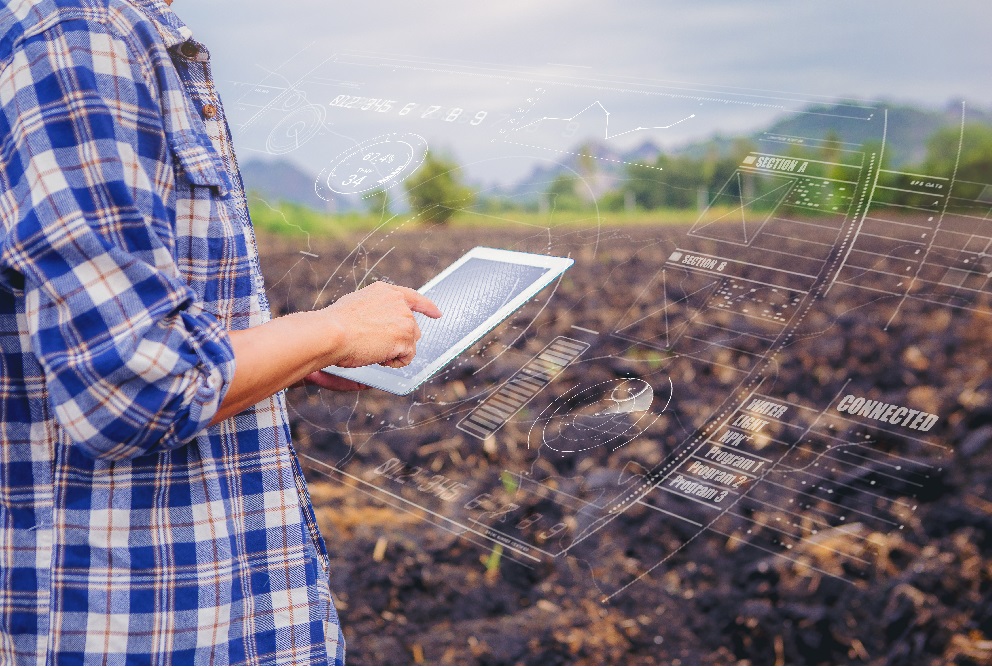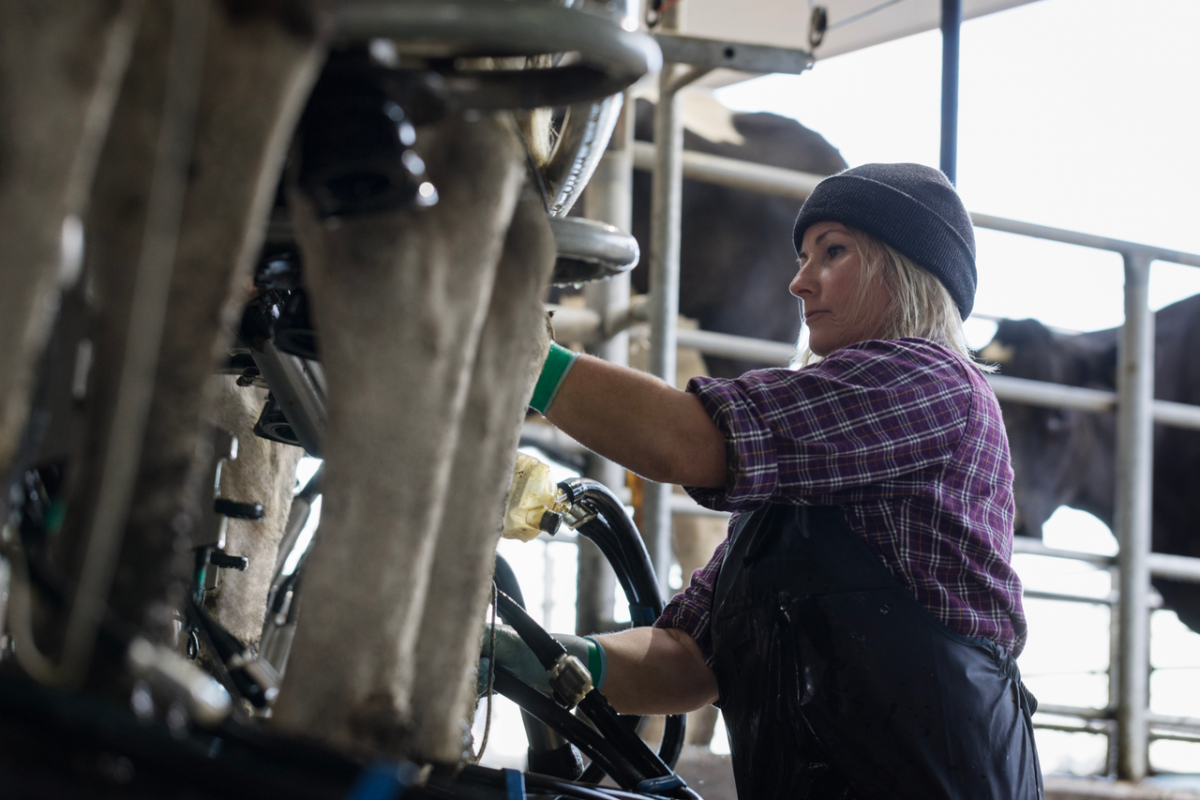Map of Ag Chief Technical Officer Andrew Cooke looks into the coming technologies influencing agriculture.
The turn of the year is often a time when we consider what has happened and what might take place. It can even be a good time to look a bit further out and consider how the budding technology trends of today might influence our future livelihoods.

The Gartner hype cycle graph demonstrates this. Starting from zero there can be a huge spike of hype about a new technology, but it is difficult to see what real-life adoption might be like on the other side of the hype. In fact, the Gartner hype cycle is just that – a “spike” of hype and then disillusionment, superimposed on a traditional cumulative technology adoption curve. The challenge in reading technology trends is to understand which may be pure hype, which have potential long-term application, and what the underlying adoption curve might be.
While the spike of inflated expectations may make it hard to assess which technologies will be adopted, it can also serve to bring forward adoption that might otherwise take years. Expectations drive investment, and investment can speed technology development beyond the purely incremental.
So, what rising technology trends might impact agriculture in the coming years? Three trends encapsulate several different technologies and their common opportunities and challenges.
- Augmented intelligence
- Connected sensing and automation
- Trust architecture
Augmented intelligence
The typical phrase that is used is “artificial intelligence” (the type of “AI” that doesn’t involve insemination!). But it’s important to look a bit wider than just artificial intelligence and consider a set of related technology trends that revolve around “augmenting” or assisting our understanding and decision making.
Trends in this space include:
Pattern recognition technologies
These are tools and systems that train machines to recognise patterns in data. Depending on the types of data involved, this can include computer vision (various types of image processing), and natural language recognition and semantic analysis (understanding what people say). It can include the use of “deep learning” (training computers to recognise patterns, and then reusing that learning) and “machine learning” (automatically finding mathematical relationships between data). These technologies are often collectively called artificial intelligence.
A key use of pattern recognition is to collect data without human effort. Examples include monitoring milk to anticipate somatic cell count or using satellite images to monitor crop growth stages and disease or nutrient problems. Companies are using these technologies now, but the coming years will bring scale, reduced costs, and the ability to “connect things up” and use this “recognised” data for multiple purposes.
Digital twins
Digital Twins are systems that take real-world data about farms, crops, and livestock, and place that data into mathematical models that help us with visualisation or prediction. The models themselves may include relationships discovered through machine learning analysis or more traditional scientific trials and human-developed algorithms – or even combinations of both.
Digital twins can provide early warning of infection or stress in livestock and crops. They can help us to visualise the nitrate or methane emissions of farm systems and undertake “what if” style analyses of different options.
Digital twins and connected data allow for predictive models and smart visualisations to be updated more frequently and analysed at greater scale than was previously possible.
Mobile applications and faster networks with improved coverage will allow us to access insights from augmented intelligence “as we need them” – either in real-time as decisions need to be made, or in the right context for our work. Experiments with virtual reality, augmented reality, speech recognition and related tools may also provide new ways to see, hear and interact with the outputs of augmented intelligence.
Connected Sensing and Automation
One source of the data that will drive future decision technologies is the spread of affordable and connected sensors.
The “Internet of Things” (IoT) is the term used to describe a network of connected sensors and actuators used to gather data and control systems. IoT devices make use of a variety of modern networking technologies (short and long range) to deliver information to the cloud, and sometimes to take instructions from centralised servers.
Newer battery technologies, and at times use of solar energy, enable network connectivity and more frequent measurements than would have previously been possible. Modern IoT devices may receive updates to their embedded software over the network, allowing problems to be corrected and functionality to be improved.
Importantly, IoT devices are often (though not always) more affordable than previous generations of sensing and automation devices, and therefore can be deployed in greater quantities, giving a corresponding increase in granularity or scale of monitoring.
IoT and other connected devices and sensors are increasingly changing how we measure and manage in farming and environment systems. For instance:
Automating data collection tasks that farmers would have previously had to undertake manually (if they were undertaken at all). Examples include recording the activities involved with milking animals, including quantity and characteristics of milk. Lightweight sensor devices on animals collecting animal wellbeing, movement, and feeding information much more frequently than livestock keepers could otherwise hope to observe in their animals.
Movement and temperature sensor data – when combined with the augmented intelligence already discussed – can predict heats, infections, even stress and boredom. We have long been able to download yield information from combine harvesters, although the task of walking with a USB stick has sometimes stopped that data being used. An internet connected harvester, however, becomes a very large IoT device, collecting yield data and quality assessments in real-time. As the data can be collected without human intervention, it is more likely to be leveraged with soil, satellite, and hydrology data to support future intelligent decisions.
Catchment-scale monitoring of rivers for nutrient flows once occurred with monthly data collection visits from sensors. New floating IoT sensors will collect river metrics in real time. The increased time-series granularity will allow us to understand whether we are seeing real improvements or declines in water quality, or merely the response to local rainfall events. In combination with farm activity data and intelligent models, farmers may even gain insights into the practical activities they can undertake to improve ecosystem health.
Connected sensors may soon support the logical next step in automation: responsive environments. Sensors, data networks, and digital twins combine to support machine-driven controls that operate within constraints that farmers define.
This is the agricultural equivalent of a car that uses radar to keep its distance from the car in front, or your phone which adjusts its screen brightness in response to the ambient light. We’re starting to see early examples of creating responsive environments in agriculture such as:
Targeted application of nitrogen to crops based on their growth stage, farmer decisions, and real-time measurement with N sensors
Irrigation systems that apply dairy shed effluent to fields taking into account soil moisture sensors, effluent pond levels, and forecast rainfall
Greenhouse control systems that automatically adjust air flow, temperature, and irrigation based on plant growth stage, sensors, and rules the grower has set, rather than purely based on a pre-programmed recipe.
Trust Architecture
A common thread to these technology trends is substantially greater collection and use of data. Much of the processing will be carried out by sophisticated computer software operating in the cloud.
For many farmers, this could sound like an Orwellian nightmare: their farm and activities under continuous observation, remote decision making, and the threat of a remote “big brother” making judgements.
It’s fair to ask whether the benefits that technology promises are worth the loss of privacy and control.
Farmers, their suppliers, and their downstream customers will not gain the full benefits of augmented intelligence, connected sensing and automation, and other technology trends unless the questions of trust, control, and security can be satisfied.
Fortunately, in the same way that technology is bringing us new solutions for collecting and interpreting data, progress is being made in the components needed to support digital trust across the industry.
One of the key needs is a coordinated model for data permissions. Those who create data in their business (or more precisely, about whose business the data is collected) need to control how that data is used.
This is not just a case of restricting access. Indeed, it may be one of extending access – being able to give appropriate data access to staff and co-workers, or to vets and agronomists. Farmers and growers may want to provide subsets of data to supply chain partners, input suppliers, or software tools of their choice. They may need to control the types of data accessed, agree the purpose of access, and even change their mind and remove access.
Frameworks in this space are still evolving and it’s an area that is full of acronyms. The most widely used framework is a specification called OAUTH 2.0 (Open Authentication). This provides a secure way of granting data access to software systems but doesn’t facilitate agreements between people or organisations. An in-development extension to OAUTH 2.0, UMA or User-Managed Authentication provides a centralised way to control data from multiple sources but is also focused on software access only.
Distributed ledgers may offer some long-term solutions in this space. Distributed ledger technology is the cryptographic engine that underpins blockchain and crypto currencies, but you can use distributed ledgers without speculating on digital coins. This technology might allow digital signing of structured data access agreements – in a way that the signatures can’t be lost or fraudulently generated, and all changes and approvals recorded over time.
Data access agreements in this form could be used hand-in-glove with digital identity (a trustworthy way of linking an online identity to the real person or company that controls it) that is still under development.
While the underpinning technologies are still evolving, trusted industry data hubs and controls are starting to provide farmers with the control and delegation they need. Our Pure Farming platform is among them. It allows farmers to define data access permissions at a variety of scales, to other software systems, organisations, and individuals.
There is much still to be done around trust and security of farm data. Initiatives such as the NZ and UK Farm Data Codes of Practice, or the USA Farm Bureau Federation’s privacy and security principles help to establish the mandate for farmer and grower control of their data and to provide the principles that will underpin future data access agreements.


